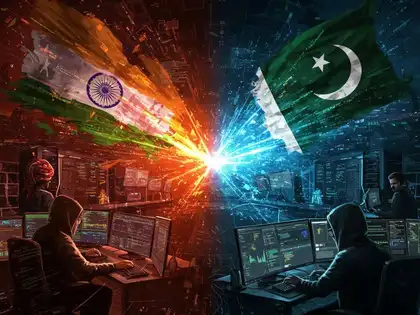In 2025 we see the India-Pakistan conflict re-Ignite by the Pahalgam attack on April 25th and made worse by India’s “Operation Sindoor” which saw missile strikes on May 7th. Now we are seeing a digital dimension to the conflict which is very serious. Reports out of Pakistan say they are planning a large scale cyber attack to disable India’s infrastructure which thus far includes reports of attacks on SCADA systems, Indian Railways, Delhi Gas and 1,744 web servers. As tensions rise between the two countries which is reported to have seen Indian strikes which killed 26 civilians according to Pakistani reports this digital shift is a new front in their conflict. This is an invisible battle which may in fact be the primary field of conflict going forward which is why it is so important to pay attention to how cyber war is played out in this rivalry.
Pakistan reported out of response to Indian actions which saw strikes at nine terrorist sites including LeT’s Muridke base. Also reported is that Pakistani hackers got into 10 of India’s SCADA systems in the energy sector, stole 150 databases and put up pro-India propaganda on government websites. Also reported is that Pakistani officials see this as a digital front to disrupt India’s tech-based advantages which in turn will not see a physical fight. India’s cyber security groups like CERT-In report to have defeated attacks from groups like HOAX1337 but that unverified report of these claims only serves to put in question. This digital war is a tell of how cyber is becoming a main tool in what is very much an unstable standoff.
In the field of cyber warfare, we see the use of digital tools which put at risk a nation’s networks, infrastructure, or data systems. We also see this as different from traditional battle which is directed at power grids, financial systems, or defence networks in order to bring about chaos, steal secrets, or stop operations. It is a quiet war with large scale impact blackouts or release of military plans can bring down a country without the firing of a single shot. In the case of India and Pakistan we see that this is not a new thing; Pakistani hackers have attacked Indian defence sites in the past and at the same time India has put up strong defences. Carried out via malware, denial of service (DoS) attacks, or data breaches, cyber warfare is a silent play which which also gives the advantage of which is very low chance of being caught thus making it perfect for a conflict which sees both sides avoid full out war.
These digital wars depend on complex strategies. We see malware including ransomware that which reports in the case of India’s SCADA outages which locked down critical systems. DoS attacks which flood servers played a role in what was reported to be Indian Railways’ outages. Also, we have data breach which puts sensitive info in the wrong hands and website defacement which serves up propaganda. Pakistan which ran a 2024 cyber defence drill which played out scenarios of Indian attacks they are prepared for this at the same time India is strengthening its cyber defences. These attacks require great tech skill and often state support which is turning the cyber space into a high stakes battlefield.
Also check:- Terrorist launch pad destroyed by BSF in Looni in Sialkot, Pakistan
Pakistan’s cyber attack may put at risk India’s economy and security, which in turn may see power and rail out falls that cause large scale disruption. India’s past ability to weather attacks is a positive sign, but a large scale assault may tax resources. For Pakistan cyber war is a cheap way to respond to economic issues. Also it is put forth by unverified X that the damage may be greater than what is actual, also we see a risk of mutual cyber harm given both countries’ digital infrastructure and nuclear issues.
As we go into the conflict, cyber attacks are expected to increase with Pakistan hitting at India’s digital core and New India retaliating. Global attempts at de-escalation which the UN puts forth and other countries present also struggle in this surreptitious field. Both states must improve their cyber security measures to guard critical systems. Also along the Line of Control which serves as the physical border a digital front has opened in which unseen attacks play out with large scale effects on South Asia’s stability.


